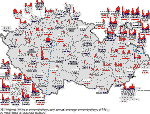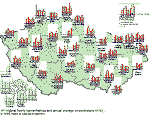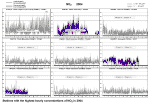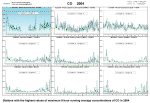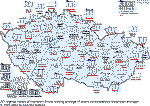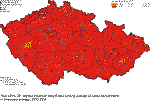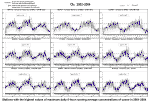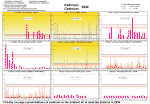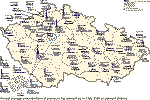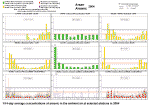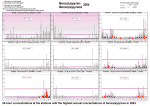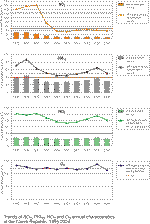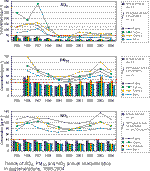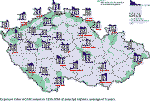|
|
AIR POLLUTION IN THE CZECH REPUBLIC IN 2004 Czech Hydrometeorological Institute - Air Quality Protection Division |
|
|
|
|
2.2 Air quality assessment The extent of air pollution is objectively determined by monitoring pollutants� concentrations in the ground layer of atmosphere within the network of measuring stations. Within air quality assessment there are compared mainly the recorded air pollution levels with the respective limit values, or with admissible exceedence frequencies of these limits which should not be further exceeded after the date in compliance with the legislation. Air quality assessment is based on the fundamental legislative document, and namely the Act No. 86/2002 Coll., on clear air protection and amendment of some other acts (Clean Air Act) in the wording of the acts No. 521/2002 Coll., No. 92/2004 Coll., No. 186/2004 Coll., No. 695/2004 Coll. and No. 180/2005 Coll. The detailed guidelines are specified in the Government Order No. 350/2002 Coll. setting forth limit values and procedures of monitoring, assessment, evaluation and management of air quality, in the wording of the Government Order No. 60/2004 Coll. The Czech legislation reflects the requirements of the European Union set by the ambient air quality directives, i.e. by the Framework Directive 96/62/EC on ambient air quality assessment and management and by the respective Daughter Directives 1999/30/EC (for SO2, NO2 and NOx, suspended particles and lead), 2000/69/EC (for benzene and CO), 2002/3/EC (for ozone and its precursors) and 2004/107/EC (for arsenic, cadmium, mercury, nickel and polycyclic aromatic hydrocarbons). This part of the Yearbook presents air quality assessment in the year 2004 with regard to the requirements of the Czech legislation on air quality protection. Pursuant to the Clean Air Act the assessment is aimed mainly at defining the areas with deteriorated air quality, with regard to health protection and the protection of ecosystems and vegetation respectively. Air quality assessment pursuant to the new legislation reassumes the results and mainly methods developed within the two research projects solved by CHMI, and namely VaV/740/2/00 �Evaluation of the Czech Republic Readiness to Meet Air Quality Requirements of EU Directives and the LRTAP Convention� [9], and VaV/740/3/02�Integrated air quality assessment and management with regard to the daughter directives on heavy metals, PAHs, PM10 and benzene� [23]. The complete results of the solution of the projects VaV/740/2/00 and VaV/740/3/02are available at the CHMI websites. The EU air quality directives on which the Czech legislation is based require that the member states should divide their territories into zones and agglomerations while the zones are understood as basic units for air quality management. The directives specify namely the requirements for the assessment – the classification of the zones with regard to air quality. The Clean Air Act covers this issue in par. 7 dealing with special air quality protection. Article 1 introduces the term �area of deteriorated air quality� for a specified part of territory (zone) or settlement locality (agglomeration), where a value of one or more air quality limit values or ozone target values or value of one or more air quality limit values, enlarged by the relevant margins of tolerance, are exceeded. Special air quality protection is required in agglomerations, i.e. in specified settlement territory, with at least 250,000 inhabitants, or territories with smaller population, where the population density requires special air protection measures and the necessity to assess and manage air quality in the territory. Within the project VaV/740/2/00 the agglomerations were proposed pursuant to the Directive 96/62/EC. The proposal is based on the number of inhabitants and on the results of the long-term air quality assessment (Table 2.2.1). The Prague and Brno agglomerations represent the areas where air pollution is connected mainly with high density of population, in the Ostrava agglomeration, covering the cities of Ostrava, Karviná, Havířov, Český Těšín and Třinec, and in the Ústí nad Labem agglomeration, covering the belt of north-Bohemian industrial cities in the coal basin (Ústí nad Labem, Děčín, Teplice, Most, Chomutov, Litvínov, Klášterec nad Ohří and Kadaň) air pollution is influenced also by high concentration of industrial plants. Due to the delineation of agglomerations air quality assessment in these areas will be determined mainly on the basis of regular and quality measurements. In the areas not included into the category of deteriorated air quality, i.e. in the areas where no limit values are exceeded, it is necessary to ensure the maintenance of good air quality. This corresponds with one of the basic principles of the Directive 96/62/EC, which requires that the once reached complying air quality continues to be maintained in the future. For the areas with deteriorated air quality the Clean Air Act in its Article 6, par. 7 sets the obligation for the regional and local authorities to develop programs aimed at the improvement of air quality for those pollutants which show limit values and of tolerance exceedences (in case of ground-level ozone target air pollution limit values), with the aim to reach the limit values in the deadlines set in the implementing regulations. The definition of the areas in which air pollution limit values set by the Government Order are exceeded is a necessary prerequisite for the preparation of programs aimed at the improvement of air quality, or of the regulation rules at the regional and local levels in these areas. In accordance with the generally accepted interpretation in the member countries, the areas delineation is primarily to be based on the administrative division of the country to allow the areas, as administrative units, to meet the requirements of the directives for air quality assessment, reporting to the Commission, and air quality management.
Tab. 2.2.1 Proposed agglomerations 2.2.1 Mapping spatial distribution of air quality characteristics The Czech legislation takes over general approaches of air quality assessment and potential exceedences of the set limit values in the zones from the Framework Directive 96/62/EC for air quality management with the aim to reach, in the set deadlines, air quality complying with the air pollution limit values and target air pollution limit values. The Directive specifies that in the areas over the UAT, measurement of ambient air pollutants is decisive for determining air pollution levels. Air pollution levels must be determined for the whole zone rather than covering the mere surroundings of the monitoring station. The problem of air quality assessment in zones – particularly identifying and locating areas within the zone in which limit values may be exceeded, based on measurements – therefore becomes a problem of estimating (throughout the zone) the spatial distribution of air quality; it consists in how to generalise �point� measurements, given the particular density and distribution of monitoring stations and an acceptable error of the estimate, to the entire zone under review. The spatial coverage measurements can be increased by validation measurements. However, the ambient air quality directive and consequently, the national legislation, do not stipulate measurements any longer as the only tool for determining levels in a zone, and envisages – depending on pollution levels – the use of modelling techniques and expert estimates and their combinations. An advantage of modelling is that in comparison with point measurements it better reflects the coverage of the area under review; nevertheless, models are generally regarded as less accurate than measurements. Under modelling mainly causal dispersion and transport models are understood, including chemical transformations of the pollutants. An important role is played also by empirical, mathematical-statistical models of the estimate of time or spatial distribution of air pollution characteristics. The maps of air pollution characteristics and atmospheric deposition are constructed by integrating GIS system, relational database and modelling which is possible by using the high-performance hardware and the latest software. The important role is also played by supplementing and correcting the objective calculations on the basis of expert estimates made by the authorised institution. Using these methods we are able to carry out air pollution assessment in a very good quality and to create adequate user-friendly visualizations and presentations, both for the decision makers or administrative bodies and for specialists and general public. Apart from the results of direct measurements of air pollution concentrations the results obtained from modelling are also used. For the territory of the Czech Republic the Gaussian dispersion model SYMOS 97 is used which calculates the concentrations on the basis of detailed emission inventories and data on meteorological conditions relevant for the assessed calendar year. The territory of the Czech Republic is divided geomorphologically into 47 areas which have different meteorological conditions. Each of the area is characterized by a wind rose, one of the inputs into the model. The calculation includes the latest available information on air pollution sources from the ISKO emission database and information on emissions from line sources. Apart from the sources on the territory of the Czech Republic the calculation includes also the available information on emission from sources abroad which plays an irreplaceable role in calculating concentrations in border areas but can be applied in the regions located further from the borders as well. One of the important precondition for creating fields of concentrations is a careful selection of the measuring stations included in the assessment, from the perspective of their use, classification and representativeness. Linear regression of the dependence of the two approaches (modelling and measurement) is applied when producing final information for map compilation in the assimilation of modelled and measured data, while a modified version of IDW, with the station�s weight and determination of its representative surroundings factored in, is applied to create the resulting fields. The basic approach to determine the degree of representativeness is station classification. Background stations (rural or urban background) with a high degree of representativeness (dozens of kilometres) are stations affected only by remote sources, while to describe local conditions stations exposed to traffic and industry are taken into account the least area of representativeness of which is directly affected by local sources. A new term �hot-spot� is used in the assessment, generally used for localities with high level of ambient air pollution. In our assessment, however, this term refers to the stations oriented exclusively to traffic and to the resulting air pollution loads. These stations meet the criteria for the location of traffic-oriented samplers pursuant to the Government Order No. 350/2002 Coll. (at least 25 m from the edge of large crossroads and max. 5 m from the edge of the road). 2.2.2 Air quality with regard to health protection limit values In accordance with the EU legislative documents on air quality the Czech legislation sets the limit values aimed at health protection derived from the WHO recommendation. The national legislation requires to monitor and assess the following pollutants, as substances manifesting evident harmful effects on the health of the population, with regard to the health protection limit values:
The survey of the limit values, margins of tolerance for the protection of health, and UAT and LAT according to the Government Order shows the Table 2.2.2. These limit values, including the UAT and LAT have been set by the legislation as the levels for air quality assessment. The maps and charts presented below use the indication of the respective limit values (categories) as shown in Table 2.2.2. The air quality assessment is documented by the tables showing the localities with the highest values of air pollution characteristics assessed pursuant to the Czech legislation. The shades of the background in the tables indicate:
All tables present at least 10 stations with the highest values of the respective air pollution characteristic. The maps depict clearly the development of the respective characteristics in the period 1992–2004. The 2004 exceedence of the limit value increased by the margin of tolerance is marked with red names of the stations. Further, maps depicting the spatial distribution of the characteristic are presented. These maps show also the measuring stations marked with different symbols and colours according to their type and category of the level of the respective characteristic measured at the presented station. For the stations and air pollution characteristics, where the number of exceedences incl. the margin of tolerance was higher than it is allowed, the courses of 24-hour or hourly concentrations in 2004 are presented for the indication of the period of the year during which the limit values were exceeded. In 2004 this chapter is concluded by the graphs showing the trends of the characteristics of selected pollutants in agglomerations and in the Czech Republic in the period of 1994–2004. The values in the graphs are calculated as total average from average concentrations of those stations which measured the monitored pollutant for the whole period 1994–2004. 2.2.2.1 Sulphur dioxide The 2004 situation of air pollution caused by SO2 with regard to the limit values set by the legislation is documented by the Tables 2.2.3–2.2.4 and Figs. 2.2.1–2.2.4. It is evident from Figs. 2.2.1 and 2.2.4 that in 2004 the set air pollution limit value for 24-hour SO2 concentration 125 μg.m-3 was not exceeded more than 3x at any locality. The annual SO2 air pollution limit value was not exceeded at any locality. Similarly, no measuring site reported the exceedence of the allowed number of exceedences of hourly SO2 concentration (380 μg.m-3). The highest number of exceedences of the SO2 hourly limit value was recorded at the ČEZ station Komáří Vížka (2x). The map diagrams in Fig. 2.2.1 show the distinct improvement of air quality resulting from the significant decrease of SO2 concentrations documented by the marked decline of the 4th highest 24-hour SO2 concentration at all stations in the period 1997–2000. In the following years this decreasing trend was less significant and in several areas slightly increased levels were recorded again. In 2004, unlike the previous year, there occurred a slight decrease in SO2 pollution in several areas of the Czech Republic. Figs. 2.2.3 and mainly 2.2.4 should, in compliance with the requirements of the Czech legislation, document the limit values exceedence episodes. Fig. 2.2.4 confirms the recent years situation in the environs of the ZÚ station Úštěk. In 2004, however, the 24-hour concentrations exceeded the set limit value of 125 μg.m-3 in 2 cases only. Fig. 2.2.2, presenting the spatial distribution of the 4th highest 24-hour
SO2 concentrations, and the Tables 2.2.2 and
2.2.4 show that in 2004 the air
pollution caused by SO2 did not exceed the limit values for the protection of
health in more than tolerated number of exceedences. Consequently, the pollution
caused by SO2 is not the reason to list any part of the territory among the
areas with deteriorated air quality. Tab. 2.2.4 Stations with the highest numbers of exceedences of the 24-hour limit value of SO2 Tab. 2.2.5 Stations with the highest values of annual average concentrations of SO2 Fig. 2.2.1 4th highest 24-hour concentrations and annual average concentrations of SO2 in 1992–2004 at selected stations Fig. 2.2.2 Field of the 4th highest 24-hour concentration of SO2 in 2004 Fig. 2.2.3 Stations with the highest hourly concentrations of SO2 in 2004 Fig. 2.2.4 Stations with the highest 24-hour concentrations of SO2 in 2004 2.2.2.2 Suspended particles, PM10 fraction Air pollution caused by PM10, as shown in the Tables 2.2.6 and 2.2.7, similarly as in Fig. 2.2.5, remains one of the main problems of air quality assurance with regard to the requirements and deadlines of the legislation. Fig. 2.2.5 shows the increasing trend of PM10 pollution at almost all stations in the Czech Republic from 2001 to 2003. In 2004 this trend stopped and, on the contrary, the PM10 concentrations decreased at almost all selected stations. From the meteorological aspect the year 2004 was much wetter than the year 2003, which, on the contrary, was extremely dry. This fact was apparently the main cause of the decline of PM10 concentrations in 2004 as compared to 2003. The most affected area of large coverage is, similarly as in the previous years, the Ostrava Region. The limit value of 24-hour PM10 concentration increased by the margin of tolerance was exceeded more than 35x in 2004, and namely at the stations in the Moravian-Silesian Region (Bohumín, Český Těšín, Havířov, Ostrava-Přívoz, Karviná, Ostrava-Zábřeh, Věřnovice, Ostrava-Fifejdy and Frýdek-Místek), at the stations in Prague (Smíchov and Legerova), at one station in the Central Bohemian Region (Kladno-Švermov) and in Ústí nad Labem Region (Horní Jiřetín, Ústí n. L.-město and Děčín). Of the total number of 94 stations at which PM10 measurements were carried out, 55 stations reported exceedences of 24-hour PM10 limit value more than 35x and 42of them reported even exceedences of the limit value including the margin of tolerance. The annual PM10 limit value was exceeded at 17 stations, and all of them exceeded also the margin of tolerance. The number of localities at which both above air pollution characteristics of PM10 fraction exceeded the limit value decreased in 2004. This was not caused by the improvement of air quality but in fact by meteorological conditions (the year 2003 was extremely dry). Figs. 2.2.6 and 2.2.7 show that PM10 limit value exceedences are, in spite of certain decrease of PM10 concentrations in 2004 as compared to 2003, still significant for listing the basic administrative units among the areas with deteriorated air quality. The limit value for 24-hour PM10 concentration was exceeded more than 35x mainly in Moravian-Silesian, Ústí nad Labem, Central Bohemian and Olomouc Regions and in Prague also in 2004. Fig. 2.2.6 shows quite evidently that in the towns where the PM10 measurements are carried out the result concentrations of this pollutant are above the limit value. However, it can be admitted that in the towns without PM10 measurements the concentrations exceed the limit value as well. The model application is difficult in this case as the model calculations include only the emissions from primary sources. The significant share in PM10 pollution is contributed by secondary particles1 and re-suspended particles, not included in the emissions from the primary sources. The areas where PM10 concentrations exceed the respective limit values represent almost 3.5 % of the territory of the Czech Republic with more than 34 % of the total population. The graphs of courses of 24-hour concentrations in 2004 at the stations, where the limit value including the margin of tolerance was exceeded, are shown in Fig. 2.2.8. The selection of 12 stations with the greatest number of LV+MT exceedences includes 9 stations from the Moravian-Silesian Region. 1Defined in [22] as: Particulate matter originated from
atmospheric reactions between sulphur and nitrogen oxides, and ammonia and
organic compounds. (see also
http://glossary.eea.eu.int/ EEAGlossary/S/secondary_particles). Tab. 2.2.6 Stations with the highest numbers of exceedences of the 24-hour limit value of PM10 Tab. 2.2.7 Stations with the highest values of annual average concentrations of PM10 Fig. 2.2.5 36th highest 24-hour concentrations and annual average concentrations of PM10 in 1994–2004 at selected stations Fig. 2.2.6 Field of the 36th highest 24-hour concentration of PM10 in 2004 Fig. 2.2.7 Field of annual average concentration of PM10 in 2004 Fig. 2.2.8 Stations with the highest exceedence of LV+MT for 24-hour concentrations of PM10 in 2004
2.2.2.3 Nitrogen dioxide The exceedence of annual limit values for NO2 occurred only in limited number of localities exposed to traffic in agglomerations and large cities. Of the total number of 142 localities at which NO2 was monitored in 2004 the annual limit value of 40 μg.m-3 was exceeded at 3 AMS stations in Prague (Legerova, nám. Republiky and Smíchov). The margin of tolerance was exceeded at the traffic-oriented �hot-spot� station Prague 2-Legerova. The Legerova station recorded a great number of exceedences of the limit value of NO2 hourly concentration – 212x, and including the margin of tolerance 18x, which represents the maximum tolerated number of exceedences per year (see Table 2.2.8). The results of this station confirm the big problem of the capital city of Prague with the traffic routes leading through the city centre. Other Czech stations (with the valid annual average) do not exceed the 1-hour limit value including the margin of tolerance. At most stations presented in Fig. 2.2.9 both the annual average concentration and the 19th highest hourly NO2 concentration had a moderately declining trend until 2001. In 2002 this trend stopped and in 2003 there was a slight increase of NO2 pollution at most localities. In 2004, on the contrary, a slight decrease of NO2 concentrations was recorded at almost all stations as compared to 2003. The field of NO2 annual average concentration (Fig. 2.2.10) shows that the relative share of this substance in the category above 32 μg.m-3 decreased. Fig. 2.2.11 presents the courses of hourly concentrations in 2004 showing the limit value exceedences. The AMS Prague 2-Legerova, established in August 2003 as a traffic �hot-spot� station monitoring the communication with heavy traffic, showed the exceedence of the limit value in 212 cases in 2004. The traffic-oriented ZÚ station Děčín OHS exceeded the limit value in 42cases. Due to measurement dropouts, however, this station has not the valid annual average and its use for air quality assessment is only limited. The construction of the map with the field of NO2 is based on the combination of measurement and modelling results; in 2004 the results of traffic-oriented modelling are applied in more details than in the previous years. With regard to the scale of modelling not all sections of roads of lower categories are included. The higher NO2 concentrations can occur also in the vicinity of local communications in the villages with intensive traffic and dense local transport network. Tab. 2.2.8 Stations with the highest values of the 19th and maximum hourly concentrations of NO2 Tab. 2.2.9 Stations with the highest values of annual average concentrations of NO2 Fig. 2.2.9 19th highest hourly concentrations and annual average concentrations of NO2 in 1992–2004 at selected stations Fig. 2.2.10 Field of annual average concentration of NO2 in 2004 Fig. 2.2.11 Stations with the highest hourly concentrations of NO2 in 2004
2.2.2.4 Lead Most lead contained in the atmosphere result from anthropogenic emissions caused by high-temperature processes, primarily the burning of fossil fuels, production of iron and steel and metallurgy of nonferrous metals. Means of transport using leaded petrol represent a very significant source of anthropogenic emissions. In the natural processes lead is released through weathering of rocks and volcanic activity [14]. Airborne lead occurs in the form of fine particles with frequency particle size distribution characterized by the average aerodynamic diameter lower than 1 μm. The long-term exposure to lead results in harmful impacts on haem biosynthesis, nervous system and blood pressure in humans. The evidence for carcinogenic potential of lead and its compounds in humans is inadequate [14, 15]. None of the total number of 61 localities which submitted sufficient data for the calculation of valid annual average in 2004 recorded the set limit value exceedence (Table 2.2.10). The highest lead concentration was reached at the locality ČHMÚ Ostrava-Přívoz, both in the PM10 fraction (58.6 ng.m-3) and in the PM2.5 fraction (55.5 ng.m-3). Table 2.2.10 shows that lead concentrations at all localities are below the limit value and do not even reach the lower assessment threshold. It is apparent from Fig. 2.2.12 that lead levels at the majority of localities do not reach the limit value in the long terms. Courses of 7/14-day average concentrations of lead at selected stations are presented in Fig. 2.2.13. Fig. 2.2.12 Annual average concentrations of lead in the ambient air in 1992–2004 at selected stations Fig. 2.2.13 7/14-day average concentrations of lead in the ambient air at selected stations in 2004
2.2.2.5 Carbon monoxide The insufficient burning of fossil fuels may be an anthropogenic source of air pollution caused by carbon monoxide. These processes occur mainly in transport and in stationary sources, namely household heating. In 2004 carbon monoxide concentrations were measured at 33 localities. Maximum daily 8-hour running averages of carbon monoxide (Table 2.2.11 and Figs. 2.2.14 and 2.2.15) do not exceed the limit value. Similarly as in the year 2003 all stations with the exception of the traffic-oriented station Prague 2-Legerova, the maximum daily 8-hour running average did not reach the lower assessment threshold. The maximum daily 8-hour running average exceeded the value of 10,000 μg.m-3 at the stations Prague 5- Řeporyje and Prague 5-Svornosti. None of these stations, however, fulfilled the requirement of the minimum 90 % of the verified data pursuant to Annex 5 of the Government Order No. 350/2002 Coll., consequently the air pollution limit value was not exceeded. Tab. 2.2.11 Stations with the highest values of maximum 8-hour moving average concentrations of CO Fig. 2.2.14 Maximum 8-hour moving average concentrations of CO in 1994–2004 at selected stations Fig. 2.2.15 Stations with the highest values of maximum 8-hour moving average concentrations of CO in 2004
2.2.2.6 Benzene With the increasing intensity of road transport the monitoring of air pollution caused by aromatic hydrocarbons is becoming relevant. The decisive source of atmospheric emissions of aromatic hydrocarbons – and namely of benzene and its alkyl derivates – are above all exhaust gases of petrol motor vehicles. Another source are loss evaporative emissions produced during petrol handling, storing and distribution. Mobile sources emissions account for approx. 85 % of total aromatic hydrocarbons emissions, while the prevailing share is represented by exhaust emissions. It is estimated that the remaining 15 % of emissions come from stationary sources. Many of these are related to industries producing aromatic hydrocarbons and those industries that use these compounds to produce other chemicals. The obtained data illustrate that benzene level in petrol is about 1.5 % while diesel fuels contain relatively insignificant levels of benzene. Exhaust benzene is produced primarily by unburned benzene from fuels. Non-benzene aromatics in the fuels can cause 70 to 80 % of the exhaust benzene formed. Some benzene also forms from engine combustion of non-aromatic fuel hydrocarbons. The most significant adverse effects from exposure to benzene are haematotoxicity and carcinogenicity [16]. The situation of the year 2004 is characterized in the Table 2.2.12 and Fig. 2.2.16. Of the total number of 21 localities monitoring benzene concentrations in 2004 the limit value including the margin of tolerance was not exceeded at any of them. Only the CHMI locality Ostrava-Přívoz exceeded the limit value by reaching the annual average 7.7 ng.m-3. The extended measurements in the year 2004 confirmed that higher concentrations are connected with industrial activities (mainly with the production of coke) in the vicinity of measuring localities (Ostrava-Přívoz). With the increasing distance the concentrations are lower (Ostrava-Fifejdy) and they decrease much lower in the residential parts of Ostrava (Ostrava-Poruba). Tab. 2.2.12 Stations with the highest values of annual average concentrations of benzene Fig. 2.2.16 Field of annual average concentration of benzene in the ambient air in 2004 Fig. 2.2.17 Annual average concentrations of benzene in 1999–2004 at selected stations Fig. 2.2.18 24-hour concentrations at the stations with the highest annual benzene concentrations in 2004
2.2.2.7 Ground-level ozone Ground-level ozone is formed under the influence of solar radiation during complex photochemical reactions mainly between nitrogen oxides, VOCs (mainly hydrocarbons) and other components of the atmosphere. Ground-level ozone is a secondary pollutant as its primary emitting from anthropogenic air pollution sources is not substantial. The Government Order No. 350/2002Coll. requires to assess the ozone concentrations in relation to human health protection as an average for the latest three years. If the latest three years are not available, the average for the latest two years or one year is taken into account pursuant to the Government Order. In 2004 ozone was measured at 61 localities out of which 43 exceeded the target air pollution limit value for the three-year period 2002–2004, or shorter (see Table 2.2.13). According to this assessment the maximum number of exceedences was recorded at the locality Krkonoše-Rýchory, where the average number of exceedences reached 79 cases. If we go beyond the national legislation requirements and assess the year 2004 separately, it can be concluded that due to the colder period April–September 2004 (i.e. the period during which the ground-level ozone concentrations reach maximum values each year) the ozone concentrations were markedly lower in 2004. In 2004 the target air pollution limit value was exceeded only in 14 localities. The maximum number of exceedences of air pollution concentration 120 μg.m-3 was reached at the station Orlické hory-Zakletý I (42x). The ground-level ozone concentrations generally grow with the increasing altitude which is confirmed also by the data measured for the year 2004. Map diagram in Fig. 2.2.18 shows the 26th highest value of maximum 8-hour running average of ozone concentrations (three-year average) in 1992–2004. The target air pollution limit value for the protection of health was exceeded in 99.3 % of the Czech Republic�s territory in the average for the period 2002–2004 (Fig. 2.2.19). Table 2.2.13 presents the stations with the highest values of maximum daily 8-hour running average ozone concentrations in three-year average. Table 2.2.14 presents the number of hours of the ozone alert threshold exceedence (180 μg.m-3) at selected AIM stations in the period of 1992–2004. Fig. 2.2.19 26th highest values of maximum 8-hour running average of ozone concentrations in three-year average, 1992–2004 at selected stations Fig. 2.2.20 Field of the 26th highest maximum daily 8-hour running average of ozone concentration in three-year average, 2002–2004 Fig. 2.2.21 Stations with the highest values of maximum daily 8-hour running average concentrations of ozone in 2002-2004
2.2.2.8 Cadmium Globally, the natural sources of cadmium represent about 10 % of which 50 % are caused by volcanic activity and 90 % by anthropogenic sources (mainly iron and steel production, metallurgy of non-ferrous metals, refuse incineration and fossil fuels combustion (brown coal, hard coal and heavy fuel oils) [17]. Emission from transport are less significant. Cadmium is bound mainly to the fine particles (aerodynamic diameter up to 2.5 μm), with higher risk of negative effects on human health. Almost all cadmium is bound to particles up to 10 μm, while the minimum amount of cadmium is found in particles with diameter above 10 μm. The kidney is the critical organ with respect to long-term exposure to cadmium. Its carcinogenic effects are evident in experimental animals and there has been limited evidence in humans so far [15, 17]. In 2004 cadmium was measured at 60 localities which submitted sufficient data for the calculation of the valid annual average (20 CHMI stations and 40 ZÚ stations, Fig. 2.2.21). Air pollution limit value including the margin of tolerance for the year 2004 was not exceeded at any locality. The limit value 5 ng.m-3 as the annual average concentration was exceeded at the locality Souš where the annual average cadmium concentration in the PM10 fraction reached 5.8 ng.m-3 in 2004. Cadmium concentrations at this locality reach high levels in the long term. The locality Tanvald characterized by long-term increased cadmium concentrations did not submit sufficient data in 2004 for the calculation of the valid annual average, nevertheless the measured values indicate the increased air pollution caused by cadmium again. The 2004 cadmium concentration courses at selected stations are shown in Fig. 2.2.23. Fig. 2.2.22 Annual average concentrations of cadmium in the ambient air in 1992–2004 at selected stations Fig. 2.2.23 Field of annual average concentration of cadmium in the ambient air in 2004 Fig. 2.2.24 1/14-day average concentrations of cadmium in the ambient air at selected stations in 2004
2.2.2.9 Arsenic Arsenic occurs in many forms of inorganic and organic compounds. The natural sources of arsenic represent about 25 % of the total emissions [17] and they include mainly volcanic activity; emissions released from vegetation are less significant. Anthropogenic sources include mainly combustion processes (brown coal, hard coal and heavy fuel oils), iron and steel industry and production of copper and zinc. Arsenic occurs largely in fine fractions (aerodynamic diameter up to 2.5 μm), which can be transported over long distances and can penetrate deeply into the respiratory system. Almost all arsenic is bound to particles with aerodynamic diameter up to 10 μm [17]. Inorganic arsenic can cause acute, subacute or chronic effects (local or affecting the whole organism). Lung cancer can be considered the critical effect following inhalation exposure [15, 17]. Of the total number of 61 localities (20 CHMI and 41 ZÚ) which submitted sufficient data for the calculation of the valid annual average for 2004 the limit value was not exceeded at any of them unlike the previous years. The highest annual average (5 ng.m-3) was reached at the Ostrava-Přívoz HS station (see Table 2.2.16). Fig. 2.2.25 shows that the total arsenic loads on the Czech Republic�s territory decreased as compared to the previous years. The courses of short-term (1/14-day) average arsenic concentrations (Fig. 2.2.27) show the seasonal character of the short-time arsenic concentrations in the ambient air and confirm the significant arsenic contribution from the burning of fossil fuels, especially in the environs of the presented stations. Fig. 2.2.25 Annual average concentrations of arsenic in the ambient air in 1996–2004 at selected stations Fig. 2.2.26 Field of annual average concentration of arsenic in the ambient air in 2004 Fig. 2.2.27 1/14-day average concentrations of arsenic in the ambient air at selected stations in 2004
2.2.2.10 Nickel Nickel is the fifth most abundant element of the earth core, though in the earth crust its percentage share is lower. Globally, 26 % of nickel is released from natural sources (continental dust and volcanic activity). The main anthropogenic sources include combustion of heavy fuel oils, mining of nickel-containing ores and nickel refinement, refuse incineration and iron and steel production. Nickel occurs in the atmospheric aerosol in several chemical compounds which differ by its toxicity for human health and ecosystems. Nickel is found in particles with aerodynamic diameter equal or higher than 10 μm (30 %) which quickly settle in the vicinity of the source. The size of the remaining nickel particles is lower than 10 μm and they can be transported over long distances [17]. The health effects include allergic dermatitis and there is evidence of nickel carcinogenicity for humans [15, 17]. None of the total number of 45 localities (20 CHMI and 25 ZÚ) from which sufficient data for the calculation of the valid annual average for 2004 were obtained, similarly as in previous years, exceeded the set limit value. The highest valid annual average concentration was measured at the locality Prague 10-Šrobárova (5 ng.m-3) which is well below the lower assessment threshold. Fig. 2.2.28 Annual average concentrations of nickel in the ambient air in 1992–2004 at selected stations Fig. 2.2.29 1/7/14-day average concentrations of nickel in the ambient air at selected stations in 2004
2.2.2.11 Mercury Main anthropogenic sources of mercury include combustion of fossil fuels, chlor-alkali production, metallurgy, cement production and refuse incineration. Mercury and its compounds are used in paint industry, battery production, measuring and control instruments (thermometers) [18]. Globally, anthropogenic emissions represent about 40 % of the total emissions. The natural sources include mercury evasion from aquatic ecosystems and vegetation, volcanic activity and de-gassing from mercury-rich minerals. It is estimated that in Europe 60 % of mercury is emitted in the form of elemental vapour Hg0, 30 % as divalent mercury (Hg (II)), and only 10 % as particulate phase mercury (H(p)). Most emission from natural sources are in gaseous form Hg0 [18]. Studies of occupationally exposed humans have shown adverse effects on the central nervous system and kidneys at high mercury vapour levels [18]. The increased concentration in the ambient air results in higher atmospheric deposition on top water layers and, consequently, in higher methylmercury concentrations in freshwater fish and its accumulation in food chains. [15, 18]. In 2004 the CHMI ISKO database received data on mercury concentrations from the CHMI locality Ústí nad Labem-město and from the locality Karviná ZÚ. Only the latter had the sufficient number of measurements for the calculation of the valid annual average. Its value was 1.4 ng.m-3, i.e. well below the lower assessment threshold.
2.2.2.12 Benzo(a)pyrene The natural background level of benzo(a)pyrene is almost zero with the exception of wildfires [15]. The cause of the presence of this main representative of polycyclic aromatic hydrocarbons (PAHs) in the ambient air is, similarly as in other PAHs the insufficient burning of fossil fuels both in stationary and mobile sources, and also some technologies, as coke and iron production. Stationary sources are represented mainly by local heating. Mobile sources are represented mainly by diesel motors. Benzo(a)pyrene as well as several other PAHs are classified as proven human carcinogens [15, 19]. In 2004 benzo(a)pyrene was monitored at 16 stations (9 CHMI and 7 ZÚ) of which 5 stations (in Ostrava, Karviná, Prague, Ústí nad Labem, Hradec Králové) report regular and long-term exceedences of the set limit values (Fig. 2.2.29). In 2004 the limit value was exceeded at 9 stations in the following cities: Ostrava, Karviná, Ústí nad Labem, Prague, Plzeň, Hradec Králové and Teplice. The limit value of the annual concentration was reached at the station Pardubice Dukla (Table 2.2.19). The station Prague 5-Smíchov which measures the increased benzo(a)pyrene concentrations is not included in the Table 2.2.19 as there was not reached the valid annual average. The field of annual average benzo(a)pyrene concentrations (Fig. 2.2.30) prepared with the use of combination of emission dispersion models and the measured concentrations illustrate the significant contribution of this component in the delineation of the areas with deteriorated air quality. The areas where the limit values were exceeded represent almost 3 % of the state�s territory with about 23 % of the population. However, it is necessary to consider that the estimates of the fields of annual average benzo(a)pyrene concentrations bear the greatest uncertainties which result both from insufficient measurement density and from uncertainties given by dispersion modelling of PAHs emissions; PAHs emission inventories represent the largest source of uncertainties. In 2004 benzo(a)pyrene measurements were extended within the national network and there were more valid annual average concentrations available than in the previous years. The future assessments will thus be based on more measurement results for creating the fields of concentrations. Further, it is necessary to note that even in the basic administrative units where there are no measurements and which are not included in the map of air pollution the increased and above-the-limit-value benzo(a)pyrene concentrations may occur due to the local sources. Tab. 2.2.19 Stations with the highest values of annual average concentrations of benzo(a)pyrene Fig. 2.2.30 Annual average concentrations of benzo(a)pyrene in 1997–2004 at selected stations Fig. 2.2.31 Field of annual average concentration of benzo(a)pyrene in the ambient air in 2004 Fig. 2.2.32 24-hour concentrations at the stations with the highest annual concentrations of benzo(a)pyrene in 2004
2.2.2.13 Ammonia Major part of ammonia emitted in the ambient air is created by disintegration of nitrogenous organic materials from domestic animals breeding. The remaining amount is emitted through combustion processes or production of fertilizers. It is apparent that ammonia emissions in the ambient air are contributed by vehicles (formation of ammonia in catalytic convertors). Ammonia has irritating effects on eyes, skin and respiratory system. Chronic exposure to increased concentrations can cause headache and vomiting [20]. Quite significant are ammonia odour annoyance impacts on the population. Ammonia monitoring was carried out at 3 localities in 2004 (2 CHMI stations and 1 ZÚ station). The measured values remained well below the limit value. The highest daily value was measured at the station Lovosice-MÚ (30 μg.m-3).
2.2.2.14 Trends of annual air pollution characteristics of SO2, PM10, NO2 and O3 for the period 1995–2004 Fig. 2.2.33 shows the trends of SO2, PM10, NO2 and O3 annual air pollution characteristics in the Czech Republic for the period of 1995–2004. Up to the year 2000 air pollution caused by SO2, PM10 and NO2 had a decreasing trend in the whole Czech Republic. In SO2 and PM10 concentrations the decline was very steep up to the year 1999. In 2001 the decreasing trend was interrupted in the whole Czech Republic and, on the contrary, a slight increase of SO2 and NO2 concentrations and a significant increase of PM10 concentrations occurred. In 2004 this increasing trend of air pollution caused by PM10 and NO2 finished and, on the contrary, certain decrease of PM10 and NO2 concentrations occurred, reaching almost the levels of the year 2001. Since 2003 a slight decrease of SO2 concentrations has been observed. In O3 there is an apparent decreasing trend up to 1997. In 1998–2002 the O3 concentrations stagnated. In 2003 the measured concentrations increased to the levels reached in 1994. In 2004, however, this graph shows that O3 decreased approximately to the level of the year 2001. Fig 2.2.34 shows the trends of SO2, PM10 and NO2 annual air pollution characteristics in 1995–2004 (PM10 since 1996) for the following agglomerations: Prague, Ústí n. L., Ostrava and Brno. Up to 1999 there was a significant decreasing trend in SO2 and PM10 concentrations in the agglomerations, the NO2 concentrations decreased only slightly. In 2001 the decreasing trend was interrupted and, on the contrary, the SO2 and NO2 concentrations slightly increased; PM10 concentrations increased significantly, mainly in the Ostrava agglomeration. In 2004, on the contrary, concentrations of all substances monitored in the agglomerations decreased with the exception of a slight increase of SO2 concentrations in the Ústí n. L. agglomeration. The cause of the mentioned decrease in the year 2004 as compared to 2003 is to be found in high air pollution levels in 2003 due to extremely unfavourable meteorological conditions (extremely dry year). Fig. 2.2.33 Trends of SO2, PM10, NO2 and O3 annual characteristics in the Czech Republic, 1995–2004 Fig. 2.2.34 Trends of SO2, PM10 and NO2 annual characteristics in agglomerations, 1995–2004
2.2.3 Areas with deteriorated air quality with regard to health protection To delineate zones and agglomerations with deteriorated air quality in line with the new Clean Air Act exceedences of annual average concentrations of SO2, PM10, NO2, lead, benzene, benzo(a)pyrene, cadmium, arsenic, nickel, mercury and ammonia were assessed for each station in accordance with the limit values and margins of tolerance set by the respective legislation. Frequencies of exceedence of daily limit values for PM10 and SO2 were calculated, as also those of exceedence of hourly limit values of SO2 and NO2 and frequencies of exceedence of 8-hour limit values of CO and ozone. The above mapping procedures were used for the preparation of the maps of spatial distribution of the respective air pollution characteristics (Figs. 2.2.2, 2.2.6, 2.2.7, 2.2.10, 2.2.16, 2.2.20, 2.2.23, 2.2.26 and 2.2.31) presented in the previous subchapters. Areas with the values of air pollution characteristics higher than the respective limit values (areas marked in red or violet) delineate the areas with deteriorated air quality. Table 2.2.21 brings the overview of areas (listed according to regions and districts) in which the limit value for the protection of health was exceeded in 2004 based on the results of mapping air pollution characteristics distribution. The exceedence percentage in the respective territory is also presented. Table 2.2.22 summarises the areas of exceedences of health protection limit values including the margins of tolerance in 2004. The tables show the per cent of exceedence of the respective limit values in the given territory for individual components and air pollution characteristics and summarize the areas in which at least one limit value of the given components was exceeded. The percentages of exceedences presented in the overview in Table 2.2.21 correspond to the percentages of the territories of the given administrative unit in which at least one air pollution limit value of the set of limit values for the protection of health was exceeded. The map in Fig. 2.2.35 depicts the delineation of areas/basic administrative units with deteriorated air quality with regard to the limit values for the protection of health, excluding ozone) in 2004. Table 2.2.23 shows the 2004 exceedence of the target limit value for ozone for the protection of health in the regions and districts of the Czech Republic and the share (%) of the respective territory. Ozone is presented separately, as it is evident that the measures aimed at the decrease of ozone concentrations exceeding the target limit value or the long-term air pollution targets, should be taken at the regional and national level. The areas with deteriorated air quality with regard to the target limit value for the protection of health are presented in the map (Fig. 2.2.20). The map in Fig. 2.2.36 presents the areas/administrative units with deteriorated air quality with regard to health protection limit values incl. ozone. Fig. 2.2.35 Areas/administrative units with deteriorated air quality with regard to health protection limit values, ozone excluded, 2004 Fig. 2.2.36 Areas/administrative units with deteriorated air quality with regard to health protection limit values incl. ozone, 2004
2.2.4 Air quality with regard to the limit values for the protection of ecosystems and vegetation Besides the limit values for the protection of health the new national legislation introduces, in compliance with EU Directives, also the limit values for the protection of ecosystems and vegetation. The survey of the limits is presented in the Table 2.2.24. Territories in which the Government Order requires meeting the limit values for the protection of ecosystems and vegetation (EKO zones):
The above territories are highlighted in the maps and specified in the
legend. The maps do not cover the proposed (not declared by the end of 2004)
protected landscape areas. 2.2.4.1 Sulphur dioxide The results of air pollution monitoring with regard to the limit value for the protection of ecosystems is shown in the Table 2.2.25 and in Figs. 2.2.37 and 2.2.38. None of the total number of 21 stations classified as rural – EKO (stations in the EKO zones meet at least one of the above a, b, c condition), which supplied data valid for the year 2004, reported the exceedence of the limit value for annual average concentration. Similarly, no EKO station reported the limit value exceedences for the 2004/2005 winter average concentration (Table 2.2.25). Fig. 2.2.37 demonstrates the significant improvement of air quality with regard to sulphur dioxide after 1997 in connection with coming into force of the Act No. 309/1991 Coll. and meeting the set emission limit values by the end of 1998. Most rural stations recorded slight decline in SO2 pollution in the 2004/2005 winter average, which is probably connected with somewhat higher temperatures as compared to the previous winter period 2003/2004. The map in Fig. 2.2.38 shows that in 2004 exceedences of the limit value occurred only occasionally and in the areas which are not included within the defined territories for the protection of ecosystems and vegetation, further in very small parts of the Krušné hory Mts. and České středohoří Mts., where the limit value exceedences do not reach even 0.05 % of the area of the defined territories for the protection of ecosystems and vegetation. Somewhat increased SO2 concentrations ranging between 12–20 μg.m-3 in the area of eastern Bohemia were calculated using the numerical model. The map was constructed from the data of all the stations measuring SO2. The spot symbols highlight only the rural stations determined for the assessment of ecosystems and vegetation. Fig. 2.2.37 Winter average concentrations of SO2 in 1992/1993–2004/2005 at selected stations Fig. 2.2.38 Field of average concentration of SO2 in the winter period 2004/2005
2.2.4.2 Nitrogen oxides Table 2.2.26 and Figs. 2.2.39 and 2.2.40 present the situation of ambient air pollution caused by NOx with regard to vegetation protection. In 2004 the annual NOx limit (30 μg.m-3) was not exceeded at any station classified as rural – EKO. Both the table and the map for the year 2004 include also the rural stations measuring NO2, as the difference between NO2 and NOx concentrations is negligible in the open landscape. In 2004 very slight decrease of annual average NOx concentration occurred at most rural stations (Fig. 2.2.39). As it is evident from the map in Fig. 2.2.40, in very limited localities of the territory defined by the Government Order on the protection of vegetation, 0.75 % of the area of the defined territory recorded the exceedence of the respective NOx limit values for the protection of ecosystems and vegetation. The occasional exceedences occurred mainly in northern Bohemia, in several small parts of the Krušné hory Mts. and the České středohoří Mts. and in the Central Bohemian Region. For the construction of the map of the field of NOx concentrations all stations measuring NOx were used including the rural stations measuring NO2. The spot symbols highlight only the rural stations determined for the assessment of ecosystems and vegetation. The construction of the map of the field of NOx concentrations is based on
the combination of measurement and modelling results; in 2004 the results of
traffic-oriented modelling are applied in more details than in the previous
years. With regard to the scale of modelling not all sections of roads of lower
categories are included. The higher NOx concentrations can occur also in the
vicinity of local communications in the villages with intensive traffic and
dense local transport network. Fig. 2.2.39 Annual average concentrations of NOx in 1992–2004 at selected stations Fig. 2.2.40 Field of annual average concentration of NOx in 2004
2.2.4.3 Ground-level ozone For the assessment of vegetation protection against ozone exceedences the national legislation uses, in compliance with the respective EU Directive, the exposure index AOT402. The survey of stations with the highest values of AOT40 is given in Table 2.2.27. Of the total number of 27 rural and suburban stations for which the AOT40 calculation is relevant according to the legislation, the air pollution target for the protection of vegetation was exceeded at 17 localities in 2004 (the average for the years 2000–2004). The target limit value for the protection of vegetation was exceeded (in the average for the same period) at 8 of 9 localities operating on the territory defined by the Government Order as the territory on which the limit for the protection of vegetation is not to be exceeded (the stations have the EKO code in the last column of the table). Fig. 2.2.41 shows the values of AOT40 exposure index in the 5-year average (min. 3 years) at selected stations in 1995–2004. The spatial distribution of AOT40 exposure index in 2004 is shown in the map in Fig. 2.2.42. It is evident that in the average for the years 2000–2004 exceedences occurred in 95.9 % of the territory in which, in compliance with the Government Order the limit value for vegetation protection is not to be exceeded. Markedly higher share of the territory, at which the ozone limit value exceedence occurred (and mainly with respect to the impacts on vegetation, less on the human health) in 2004 as compared to 2003, is given by the fact that a higher regression coefficient was used in the construction of maps. The reason was the observed steeper increase of ozone concentrations with higher altitudes in the period under review. 2AOT40: accumulated exposure is calculated as the sum of the
difference between hourly ozone concentrations and the threshold level of 80 μg.m-3
(= 40 ppb) for each hour when this threshold value was exceeded. Pursuant to the
requirements of the Government Order No. 350/2002 Coll. AOT40 is calculated for
the period of three months (May to July) measured between 8:00 and 20:00 Central
European Time (= 7:00 and 19:00 UTC). Fig. 2.2.41 Exposure index AOT40 values in 1995–2004 at selected stations, average of 5 years Fig. 2.2.42 Field of exposure index AOT40 values, average of 5 years 2000-2004 Fig. 2.2.43 Stations with the highest AOT40 values in recent 5 years, 2000–2004
2.2.5 Areas with deteriorated air quality with regard to the protection of ecosystems and vegetation Based on the mapping of air pollution characteristics distribution for the year 2004 with regard to vegetation protection (Figs. 2.2.38 and 2.2.40) the distribution of air pollution limit values exceedences is shown for annual average concentrations of NOx and winter average SO2 concentrations for the protection of ecosystems and vegetation. The assessment of the respective limit values exceedences is carried out only for the territory defined for the protection of ecosystems and vegetation in accordance with the Government Order No. 350/2002 Coll. The final designation of areas with deteriorated air quality with regard to the limit values for SO2 and NOx for the protection of ecosystems/vegetation pursuant to the Act No. 86/2002 Coll. for the year 2004 is shown in Fig. 2.2.44. Table 2.2.28 shows the shares of exceedence of the limit values for the protection of ecosystems and vegetation for individual limit values for NOx, SO2 and AOT40 for the territory defined by the new legislation. It is evident that in 96 % of the territory defined for the protection of vegetation the target air pollution limit value for AOT40 is exceeded, due to exceeding ozone concentrations (Fig. 2.2.45). Tab. 2.2.28 Shares of the territories for ecosystems and vegetation protection with the LV exceedence, % of the territory of the protected area, 2004 Fig. 2.2.44 Areas with deteriorated air quality with regard to SO2 and NOx limit values for the protection of ecosystems/vegetation, 2004 Fig. 2.2.45 Areas with deteriorated air quality for ecosystems/vegetation, exceedence of limit value AOT40, 2004
2.2.6 Conclusions The carried out assessment for the year 2004 has taken into account the
requirements of the Government Order No. 350/2002. The following problems were
indicated with regard to meeting the deadlines set by the national legislation
on the protection of ambient air.
The exceedence of limit values for the suspended particles is a major problem in most European cities. The occurrence of suspended particles in ambient air is a rather complicated phenomenon and their actual concentration expressed in mass number is represented only partially by local emission of primary particles, especially by transport emission. Further contribution to the actual concentration is represented by reemission (i.e. the whirling of already emitted particles for instance from the road surface or from building sites), and the remaining part by secondary inorganic and organic particles created by chemical transformation of gaseous components both of anthropogenic origin (SO2, NOx and non-methane volatile organic compounds), and by emission from the natural environment. Thus the problem of exceeded concentrations of suspended particles in European cities will have to be solved both within all-European cooperation, and at local or regional levels, mainly through measures aimed at local heating and by the reduction of traffic emission, including better street cleaning. Relatively high contribution of secondary particles show that significant decrease of PM10 concentrations will be possible by further decreasing of emissionof the components causing the creation of the fine fraction of secondary particles in atmospheric aerosol. This demands mainly the decreasing of nitrogen oxides and VOC emissions in compliance with the requirement to meet the national emission ceilings, but in such a way that by the deadlines set by the Clean Air Act the air pollution limit values are met for PM10. Further decrease of emissions, mainly nitrogen oxides emissions but also of VOC emissions on a large scale, is the only possible way how to decrease the loads caused by exceeding ground-level ozone concentrations. When interpreting the assessment results it is necessary to stress that the air pollution maps are based on the measurements which is focused mainly on large agglomerations pursuant to the legislative requirements. The expert estimates and the results of the published works [e.g. 24, 25] show, however, that it is highly probable that both the increased and above-the limit concentrations of a number of substances occur also in small villages where there are no measurements carried out and where lives a relatively large share of population of the Czech Republic. The substances concerned are mainly as follows: suspended particles, polycyclic aromatic hydrocarbons and heavy metals. The essential role in air pollution is played by geomorphological conditions, traffic loads and the way of heating. Due to burning wood and coal there occur increased emissions of particles, polycyclic aromatic hydrocarbons and heavy metals. Moreover, by burning refuse in local fire places dangerous dioxins are emitted in the ambient air. It is necessary to note that the presented maps have been constructed by using the best know techniques corresponding to the current level of knowledge and as such they represent the best known approximation of the actual air pollution situation. This, however, does not mean that the maps should be regarded as a dogma. The procedures of map construction have to be further elaborated and it is necessary to focus our attention mainly on the error estimate/probability which is very complicated.
|




